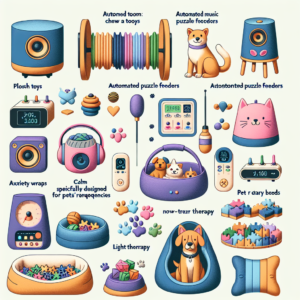- Key Takeaways
- Why Wearable Tech is a Game-Changer for Pets
- Real-Time Monitoring of Pain Symptoms
- Decoding the Data: Interpreting Pain Indicators
- Comparing Popular Wearable Pain Management Devices
- Setting Up Your Pet’s Wearable Device
- Creating a Pain Management Plan with Your Vet
- Monitoring Pain Trends Over Time
- When to Update Pain Management Strategies
- Case Study: Relief for Arthritic Dogs
- Case Study: Post-Surgery Feline Recovery
- What's Next for Wearable Pet Pain Tech?
- Cutting-edge Research and Potential Breakthroughs
- Can wearables replace veterinary care for pain management?
- How accurate are these devices in assessing pain levels?
- Are there wearable pain management solutions for all types of pets?
- Is it difficult to get pets to wear these devices?
- Can wearable devices help with long-term pain conditions?

When it comes to our furry friends, we all want to ensure they live happy, pain-free lives. But unlike humans, pets can’t verbally tell us when they’re in discomfort. This is where wearable tools for pet pain come into play, offering an innovative solution for identifying and managing pain in our pets.
Key Takeaways
-
Wearable technology can detect both acute and chronic pain in pets.
-
Devices like PainTrace and the CAPdouleur app provide real-time monitoring and data interpretation.
-
Look for wearables with features such as ease of use, comfort for the pet, and accurate pain assessment.
-
Collaborate with your vet to create a comprehensive pain management plan.
-
Keep track of your pet’s pain trends and adjust the care plan as needed.
Let’s dive into how these tools work and how they can make a significant difference in the quality of life for our pets.
Understanding Pet Pain and Its Impact
Firstly, recognizing that your pet is in pain is crucial. Pets often hide their pain as a survival instinct, which can make it challenging for pet owners to notice. Signs of pain in pets can include changes in behavior, such as decreased activity, loss of appetite, or aggression. Chronic conditions like arthritis or back pain can develop over time, making them even harder to detect until they become severe.
The impact of untreated pain in pets can be profound. It can lead to decreased mobility, depression, and a significant drop in the overall quality of life. Therefore, it’s essential to have a proactive approach to identifying and managing pain in our pets.
Why Wearable Tech is a Game-Changer for Pets
Wearable technology for pets is transforming how we understand and manage their pain. These tools provide a non-invasive, continuous way to monitor pain levels, which is especially beneficial for animals that may not show obvious signs of distress. With the help of wearables, pet owners and veterinarians can make more informed decisions about treatment and care.
Moreover, these devices empower pet owners to take an active role in their pet’s health. Seeing pain levels in real-time can motivate owners to seek treatment promptly, leading to quicker relief for their pets.

The Role of Wearables in Pain Detection
Real-Time Monitoring of Pain Symptoms
Devices such as PainTrace and the CAPdouleur app are equipped with sensors that measure physiological indicators of pain. These could include heart rate variability, body temperature, and movement patterns. By wearing the device, your pet’s pain levels can be monitored in real-time, providing valuable insights into their well-being.
For example, PainTrace is a wearable monitor that can quantify both acute and chronic pain in animals. It can detect pain that may not be apparent during a physical exam, allowing for earlier intervention and treatment.
Decoding the Data: Interpreting Pain Indicators
But what do you do with the data collected by these wearables? The devices often come with applications or platforms that interpret the data and provide a pain score. This score can help you and your vet understand the severity of your pet’s pain and the effectiveness of any ongoing treatment.
It’s important to note that while these tools are incredibly useful, they should be used in conjunction with professional veterinary advice. A vet can take the information provided by the wearable and combine it with their expertise to create a tailored pain management plan.
Comparing Popular Wearable Pain Management Devices
Choosing the right wearable device for your pet is essential. You’ll want to consider factors such as comfort, ease of use, and accuracy. Some popular devices on the market include PainTrace and products from companies like AniV8. PainTrace, for instance, is known for its ability to detect pain that might not be otherwise observable. Meanwhile, AniV8 collaborates with Elanco to develop wearable technologies that not only track pain but also monitor other health indicators.
Implementing Wearable Pain Management
Setting Up Your Pet’s Wearable Device
Once you’ve selected a wearable tool, setting it up is the next step. It’s usually a straightforward process. Start by charging the device if necessary, and then fit it onto your pet according to the manufacturer’s instructions. Ensure it’s snug but not too tight to avoid discomfort. Next, download any associated apps onto your smartphone or tablet and pair the device. You’ll typically need to create a profile for your pet, entering details like age, weight, and any existing health conditions.

Creating a Pain Management Plan with Your Vet
Most importantly, you should work closely with your vet to integrate the wearable’s data into a comprehensive pain management plan. This plan should be tailored to your pet’s specific needs and may include:
-
Medications for pain relief
-
Physical therapy or rehabilitation exercises
-
Dietary changes or supplements
-
Regular check-ups and adjustments based on wearable data feedback
Remember, the wearable provides data that, when combined with your vet’s expertise, can lead to a more dynamic and responsive approach to managing your pet’s pain.
Tracking Progress and Adjusting Care
Monitoring Pain Trends Over Time
By consistently using the wearable tool, you’ll be able to track how your pet’s pain levels change over time. This data is invaluable as it can reveal patterns and triggers that might not be obvious otherwise. For instance, you might notice that your pet’s pain levels increase after certain activities or at specific times of the day. Sharing these insights with your vet can help fine-tune your pet’s pain management plan.
When to Update Pain Management Strategies
As you monitor your pet’s pain, there will be times when you need to adjust their pain management strategies. This could be due to changes in their condition, the effectiveness of current treatments, or side effects. Regular consultations with your vet are crucial, as they can interpret the data and advise on any necessary changes. Always keep the lines of communication open and be proactive in discussing your pet’s well-being.
Remember, managing pet pain is an ongoing process, and wearables are tools that provide additional support and information to ensure your pet is comfortable and happy.
Success Stories: Wearables in Action
Case Study: Relief for Arthritic Dogs
“Max, a 10-year-old Labrador, was struggling with arthritis. His owner noticed he was less enthusiastic about walks and had difficulty getting up. After fitting Max with a wearable pain management device, they could pinpoint when his pain was at its worst. With adjustments to his medication and the introduction of gentle exercise, Max’s mobility improved significantly.”
Case Study: Post-Surgery Feline Recovery
“Bella, a Siamese cat, underwent surgery for a broken leg. Post-surgery, her owner used a wearable device to monitor her pain levels. The data showed that Bella experienced more pain at night, which prompted her vet to adjust her pain medication schedule. This led to a more comfortable recovery for Bella.”
Advancing Pet Health with Future Innovations
The future of wearable pain management tools for pets is bright, with ongoing research and development promising even more advanced solutions. Innovations may include more sophisticated sensors, machine learning algorithms for better pain prediction, and even integration with other smart home devices for comprehensive health monitoring. These advancements will continue to improve our ability to care for our pets’ health and well-being.
As we embrace these technologies, it’s important to remember that they complement, not replace, the expertise of veterinary professionals. By using wearables as part of a broader approach to pet health, we can ensure our pets live their best lives.
What’s Next for Wearable Pet Pain Tech?
The horizon for
wearable pet pain technology is teeming with potential. As we continue to push the boundaries of what’s possible, we’re seeing a trend towards more intuitive devices that not only track pain but also predict and manage it through AI-driven analytics. This could revolutionize the way we approach pet health, offering preemptive solutions to pain management that are tailored to each pet’s unique pattern of behavior and symptoms.
Besides that, there’s a growing interest in integrating wearable tech with other smart devices. Imagine a world where your pet’s collar can communicate with your smart home system to adjust the temperature, lighting, or even play soothing music when it detects your pet is in pain. This level of interconnectedness could provide an all-encompassing environment conducive to healing and comfort for our pets.
Cutting-edge Research and Potential Breakthroughs
Research in the field of wearable pet pain technology is currently exploring various avenues to enhance its effectiveness. Scientists are working on sensors that can more accurately detect pain by measuring additional physiological markers such as skin conductance and cortisol levels. There’s also interest in non-invasive therapies that can be integrated into wearables, such as light therapy or vibration therapy, which could provide pain relief on the spot.

FAQ
In this section, I’ll address some common questions about wearable tools for pet pain management. This will help clarify any uncertainties you might have about these innovative devices.
Can wearables replace veterinary care for pain management?
While wearables are a fantastic aid in managing pet pain, they should never replace professional veterinary care. These devices are designed to supplement the expertise of your vet by providing additional data points that can inform treatment plans. Regular check-ups and consultations with your vet are crucial to ensure your pet’s health and well-being.
How accurate are these devices in assessing pain levels?
Wearable devices for pets are becoming increasingly accurate, thanks to advancements in sensor technology and data interpretation algorithms. However, accuracy can vary depending on the device and the individual pet. It’s essential to choose reputable devices that have been tested and to use them as part of a comprehensive approach to pain management.
It’s also important to note that these devices are tools to aid in pain detection, not definitive diagnostic instruments. They provide valuable insights that, when combined with veterinary expertise, can lead to better pain management outcomes for your pet.
Furthermore, wearables are most effective when used consistently over time, as they can track trends and changes in pain levels that might not be immediately apparent. This longitudinal data can be a game-changer in understanding and managing your pet’s pain.
Are there wearable pain management solutions for all types of pets?
Currently, the most common wearable pain management solutions are designed for dogs and cats, as they are the most prevalent pets in households. However, the market is expanding, and there is ongoing research to develop solutions for a broader range of animals, including horses and exotic pets. The key is to find a device that is appropriately sized and designed for the specific needs of your pet.
Is it difficult to get pets to wear these devices?
Some pets may initially resist wearing a new device, but most can be acclimated with patience and positive reinforcement. It’s crucial to ensure the device is comfortable and does not impede your pet’s movement. Introduce the wearable gradually, allowing your pet to become familiar with it, and associate it with positive experiences, such as treats or affection.
Can wearable devices help with long-term pain conditions?
Yes, wearable devices can be particularly beneficial for pets with long-term pain conditions such as arthritis or hip dysplasia. By providing continuous monitoring, these tools can help you and your vet detect patterns in pain levels and adjust treatment plans accordingly. They can also help you understand how your pet responds to certain medications or therapies, leading to more personalized and effective pain management over time.



Leave a Reply